
The ReactDOM.render() method compares real and virtual DOM elements and their children to render elements on the screen. Because React elements are immutable (cannot be changed), the next element release simply replaces the previous one, similar to how animations are created. A Virtual React DOM is used to record all screenshots of new element releases made by render methods. If the props of the parent element are replaced by new ones, render will automatically take over for both the parent and the children.

Property values in a state are stored in an object with the intent of determining a component’s property value. As each component, the user is responsible for assigning function names. The render() method must return a React element, which can be either a DOM component or another React element.Ī component is a definite app task that is distinct from the main task that is a combination of logic and markup for every programmer. React elements can be either created from scratch, or cloned from existing React elements. In React, the render() method is used to output a React element to the DOM. When you want to underline a Maryland file, use the *u* HTML tag or the *ins* file. It is a simple, GitHub-flavored markdown component that makes native JSX without any hacks and takes Markdown to the next level. For example, if you have a function called foo in your code, React will mark it as running in the browser using the symbol.
REACT MARKDOWN CODE
As a result, React will use the marked code to execute the corresponding block of code. If a specific element of a React code is marked, React will analyze the code to see if any other elements have been marked. React Uses Marked To Run Code In The Browse Because react-markdown does not use the dangerousSetInnerHTML prop, you can use it safely to render markdown. Referencing is a method of notation that is used in this application. What is react-markdown and why is it important? React’s react- markdown component converts Markdown text into HTML code. Then, under File > Import > Markdown File, select Import. Import a Markdown file Choose the folder where you want to import the Markdown (for example). I don’t understand why it works the way it does. When reading the const readmePath variable, you must add an empty string (since the required location is already there). The function return:Effect must include a reference to the state variable in order to be called. If you want to import Markdown using a.js file, add the backtick’character to the literal literal in the markdown to enclose it. To supplement the componentWillUpdate method, I used hooks and effect (which is different from componentWillUpdate but still works). Electron React Boilerplate) can be used to save a few steps by loading it into a Webpack loader. If you use Typescript, you don’t have to bother with the webpack configuration simply wrap your existing with a withMDX function: about.mdx if you use React. Finally, I render it on the page using the dangerouslySetInnerHTML attribute. When there is a text response, mark(text) it. When I do a componentDidMount event, I keep the event in its state. What do I need to load the.md file? I use marked GitHub (the first time I import it), and the first thing I do is import it.

I’ve searched the internet for libraries, but I couldn’t find a good one. How do I load a markdown into a react component? I’ve tried so many different things.
REACT MARKDOWN INSTALL
To get started, install marked with npm: npm install marked –save Then, in your React component, you can import marked and use it to render Markdown: import React from ‘react’ import marked from ‘marked’ class M圜omponent extends React. It’s fast, easy to use, and it works with React out of the box.

Marked takes Markdown text and converts it to HTML. To render Markdown in React, you can use a library like marked. For example, you can use Markdown to format text in your README file, or in comments in your code. If you’re new to React, you can use Markdown to format text in your components without having to learn another templating language. In fact, Markdown is so simple to use that you might not even need a tutorial. Markdown is a simple way to format text that looks great on any device.


 0 kommentar(er)
0 kommentar(er)
